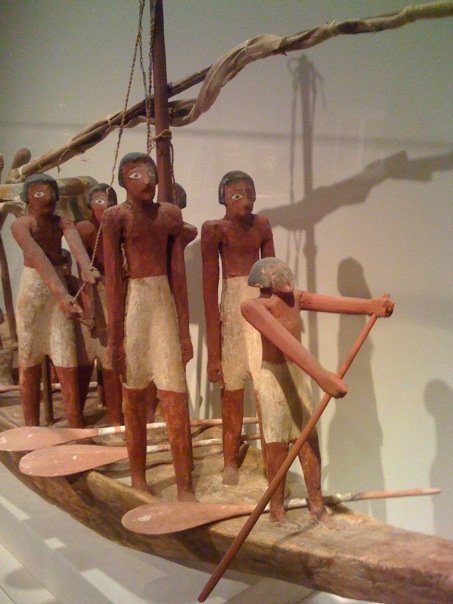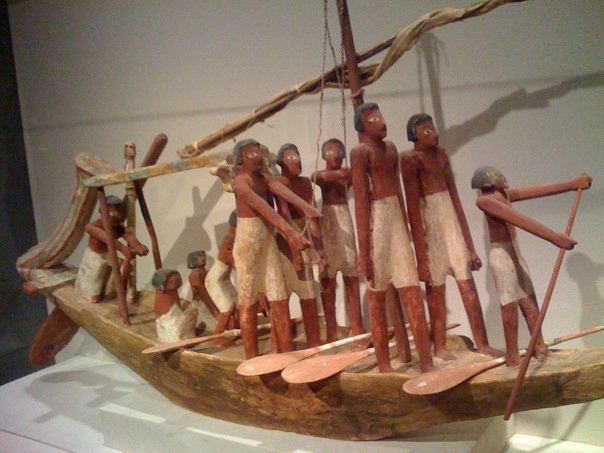"Museum Paper: 'Model Boat' at RISD Art Museum" By Eric Johnson '11
John Berger writes, "We only see what we look at. To look is an act of choice."(1) I did not enter the Rhode Island School of Design Art Museum with one item in mind that I wanted to observe. In the ancient Egyptian collection alone, I had plenty of choices, including an eye-grabbing golden sarcophagus, but I chose to look at a model boat from c. 2100-1900 BC. It was painted in mostly dull reddish hues and, size-wise, was about 3-4' x 2' x 2-3'. The museum plaque lists its components as "Wood (probably sycamore), painted; linen." I cannot derive the meaning of all of Egyptian civilization from this boat, but I can look at it and see it as one item with its own purpose in the grander scheme of all artwork output during the same time period and over time by the same people.
Why did I choose this model boat? Having little to no knowledge of Egyptian art coming in to the museum (I visited a traveling King Tut exhibit in 2006, but all I remember are the big pieces like the stone carvings and the sarcophagi), I certainly was not looking for a particular style. That is, I did not have a firm reference point for how this boat compared to any other depictions of boats or to any other models that were discovered in tombs. I look at the boat innocently, not thinking it might have some grand significance and untethered from the thought process that accompanies works of art by one known artist. Additionally, my initial two questions about the boat—who made it and who saw it—go unanswered. These are the questions I assumed would be easiest to answer, but I move on to looking at the object itself rather than thinking about its origin. I begin a sketch in my logbook, trying to replicate what I see. Not satisfied with my crude drawing, I take photos and video as well.
Video of the model boat, link goes to YouTube

Ten humans of varying sizes sit, stand or squat on the boat, which is apparently being propelled through the water by a smaller person or maybe a dwarf with a stick at the fore of the vessel. In the very back of the boat, another smallish man sits, apparently controlling the rudder, which extends downwards from the rear of the boat. Four oars sit balanced on the boat, perpendicular to its length; none are in use. Behind this "captain," five tall men who look roughly identical stand in two rows. Three of these men, the ones in the back row, are holding the rigging for the sails, which are furled around the mast. All five have greatly enlarged pupils and no eyelids painted in. My visit occurred on September 20, so I was promptly reminded of the Abu Temple statues from the previous Monday's lecture. While those statues were found in a reverential pose, nothing about the pose of the five bug-eyed men suggests any information as to what they are seeing.
Behind the tall men there is an awning, which is striped like the back and front of the boat. Underneath it, one smaller figure bends over, possibly in an attempt to reach the oar on the ground in front of him, while two even smaller figures sit. Comparing these two figures, which are otherwise similar in appearance, one's hair curves down in a feminine form around the head, while the other's hair more closely resembles the flat-topped hair of the men on the boat. It is here, however, that I pause in my note taking. I am reminded of Renata Holod's "Rite of Site," in that I am looking at this model boat from a time period so far away from when it was made that I may be jumping to irrational conclusions.(2) I do not know that the hairstyles of the people on the boat could have been shaped differently to suggest sex--I am assuming so because that's what I have been made accustomed to in my life.
There is no mention made on the museum plaque of who might have been responsible for the artifact, but it does hint at a narrative behind the static scene depicted on it. "Just as the Egyptians used boats in life on the Nile, so they believed such crafts were necessary in the Beyond," it reads. Once again, I am reminded of Renata Holod. I presumed that even if this piece was not seen as widely as it is today, in a glass case in a museum in a college city, the boat was a motif throughout Egyptian art and ritual creations. Later lectures and textbook reading would confirm this hypothesis, to a degree. But on the day of my visit to the art museum, I saw the boat on its own, not within range of other model boats or in its original site. "Two or more model boats like this example were included in tombs of the First Intermediate Period," the plaque continues. Thinking of the River Styx in Greek mythology, my next presumption is that this boat was related to the carrying of the dead. Perhaps, like the Books of the Dead, this model was intended to help guide those it was interred with? The remainder of the plaque does not fill in the holes in this possible narrative, saying that Egyptians "wished to voyage in the afterlife to Abydos in southern Egypt."
Possessing only my patchy guess at a narrative, I turn to representation and symbolism. This boat represents, at least in my interpretation, a vessel that carried the dead into the next part of their existence. It would have been spiritually valuable in that it represented a common physical element of life before and after death—trade and travel operated via boat would flow directly into the embarking of a boat that would head towards the afterlife. I do not want to get carried away with my analysis of this model I am seeing solely because of my knowledge of the River Styx, but it’s difficult not to let the two mythologies intertwine in my head. Does the boat symbolize something greater, specifically about Egyptian life, culture and society? Is there something more to this boat than a ritual purpose? No, I think to myself. I jot down some thoughts in my logbook. I see this boat as one thing, separated from all other things here in this exhibit. Out of a handful of artistic metrics for evaluation--style, iconography, narrative, representation and symbolism--the one that I am best able to fill in is the narrative, and even in that regard I have more a hypothesis than a conclusion.
But even if I am unable to divine some sort of final conclusion from looking at this model boat (not that I particularly expected to before observing it), what can I conclude more generally from this experience in seeing? The boat is extraordinarily detailed, despite the fact that it was interred with a corpse in a tomb; the context provided by the plaque proposes that the boat’s purpose was directly linked to boats’ spiritual function for the dead; and the figures on the boat, while not resembling skeletons or dead bodies, appear to be headed somewhere, and judging from the expression on the faces of the five tall men, they may already be in sight of the thing or place that they head towards. The more basic questions about art, separate from iconography, such as who the artist was or who, specifically, saw the work, remain unanswered, but I only think to ask those questions because that’s what I’ve been taught to jump to from my limited art education. In total, I walk away from the RISD museum concluding that looking at and seeing ancient art is different not only in terms of right of sight, but also in terms of rite of sight. I cannot answer the questions with which I approached this model boat, but ultimately, this does not impair my ability to see it and start to understand it.
(1) Berger, John, et al. “Ways of Seeing.” Adapted from BBC television series of the same name. Penguin.
(2) Holod, Renata. “Site of Sight, Right of Sight, and Rite of Sight: Exploring the Cultures of Seeing.” http://mediamogul.seas.upenn.edu:8080/ramgen/sas_exaff/60sec/holod_256_384.rm

